BPMNمخفف مدلسازی فرآیند کسبوکار است. BPMN بسیار شبیه به مفهوم نمودار جریان است که از دهه 1980 وجود داشته است. مانند نمودار جریان، مدلسازی BPMN هدفش این است که به یک فرد اجازه دهد یک جریان کار را به گونهای ترسیم کند که به راحتی توسط سایر طرفهای ذینفع قابل درک باشد.

BPMN iیک زبان است و مانند هر زبان دیگری هدف آن تسهیل ارتباط است. BPMN برای تسهیل ارتباط و درک فرآیندهای کسبوکار طراحی شده است.
BPMN نرمافزار نیست و به یک کسبوکار «مالک» نیست، بلکه توسط OMG (گروه مدیریت شیء) به عنوان یک استاندارد نشانهگذاری توسعه یافته است که میتواند توسط تحلیلگران کسبوکار، توسعهدهندگان فنی و مدیران پروژه درک شود.
BPMN 2.0: چه خبر جدیدی دارد؟
BPMN 2.0 چند سالی است که وجود دارد و دارای چندین ویژگی و مزیت جدید نسبت به نسخههای قدیمیتر است. نسخههای قبل از 2.0 کمتر سازگار، از نظر فناوری بالغتر نیستند و به خودکارسازی کمتر قابل قبول هستند. بسیاری از نمودارهای ساخته شده تحت نسخههای قدیمیتر BPMN منسوخ شدهاند و وقتی تحت BPMN 2.0 ارائه میشوند، بسیار مفیدتر و معنادارتر هستند. BPMN 2.0 بزرگترین بازنگری BPMN تا کنون است که بهبودهایی در عناصر بصری BPMN و عناصر «داخلی» BPMN مانند معناشناسی انجام شده است.
BPMN 1.2یک نگاشت از یک نمودار BPMN «معتبر» به BPEL ارائه میدهد، به گونهای که یک موتور بتواند فرآیند را اجرا کند. مشخصات 1.2 فقط توصیفهای کلامی محدود از عناصر نشانهگذاری گرافیکی و قوانین مدلسازی را ارائه میدهد. این منجر به گمراهی و سردرگمی در فرآیند ترجمه میشود.
BPMN 2.0 بزرگترین بازنگری BPMN از زمان تأسیس آن را نمایندگی میکند. BPMN 2.0 یک تعریف رسمی به شکل یک متامدل دریافت کرد، که یک تعریف دقیق از ساختارها و قوانین مورد نیاز برای ایجاد مدلهای خاص است.
برخی از تغییرات اصلی که نسخههای 2.0 BPMN با خود به ارمغان آوردند عبارتند از:
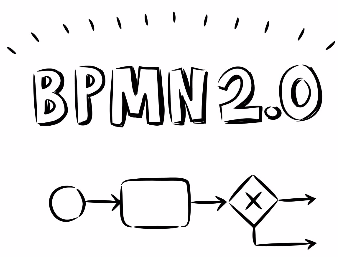
- اضافه شدن یک نمودار رقص.
- اضافه شدن یک نمودار گفتگو.
- رویدادهای غیرمداخلهگر برای یک فرآیند.
- زیرفرآیندهای رویداد برای یک فرآیند.
تغییرات عمده فنی شامل:
- تعریفی از معناشناسی اجرای فرآیند.
- یک متامدل رسمی که از طریق نمودارهای کلاس نشان داده شده است.
- فرمتهای تبادل برای تبادل مدل نحو انتزاعی در هر دو متادیتای XML
- تبادل (XMI) و تعریف طرحواره XML (XSD).
- فرمتهای تبادل برای تبادل نمودار در هر دو XMI و XSD.
- تبدیلات زبان شیوهنامه قابل گسترش (XSLT) بین فرمتهای XMI و XSD.
تغییرات فنی دیگر شامل:
- وظایف مرجع حذف شدهاند. اینها قابلیت استفاده مجدد در یک نمودار واحد را فراهم میکردند، در مقایسه با وظایف جهانی که در چندین نمودار قابل استفاده مجدد هستند. فعالیت تماس جدید میتواند برای ارجاع به یک وظیفه جهانی یا یک فرآیند دیگر که در یک فرآیند استفاده شود (به جای وظایف مرجع) استفاده شود.
به دلیل بهروزرسانیهای نسخه 2.0، تعداد عناصر بیش از دو برابر از 55 عنصر به 116 افزایش یافته است. بسیاری از این عناصر جدید به مدلسازی تعاملات بین فرآیندها و/یا موجودیتها، مانند نمودار رقص جدید، اعمال شدهاند.
BPMN 2.0.2، که در دسامبر 2013 منتشر شد، فقط شامل تغییرات جزئی از نظر اصلاحات تایپی و تغییر در بند 15 بود.
آیا ابزار BPMN 2.0 پیچیده است؟
بسیاری از منتقدان BPMN 2.0 شکایت دارند که BPMN برای یادگیری بسیار پیچیده است. حتی اگر خود زبان به گونهای طراحی شده باشد که ابهام نداشته باشد و یک لایه معنایی واحد را شامل شود، به سادگی تعداد زیادی شیء در BPMN وجود دارد که استاندارد را غیرقابل استفاده میکند.
این منتقدان اغلب به تصاویری از مشخصات BPMN 2.0 OMG اشاره میکنند، مانند این ماتریس رویدادها، تا نکته خود را تأکید کنند. این منتقدان اغلب به ابزارها و روشهای مدلسازی دیگر تمایل دارند.
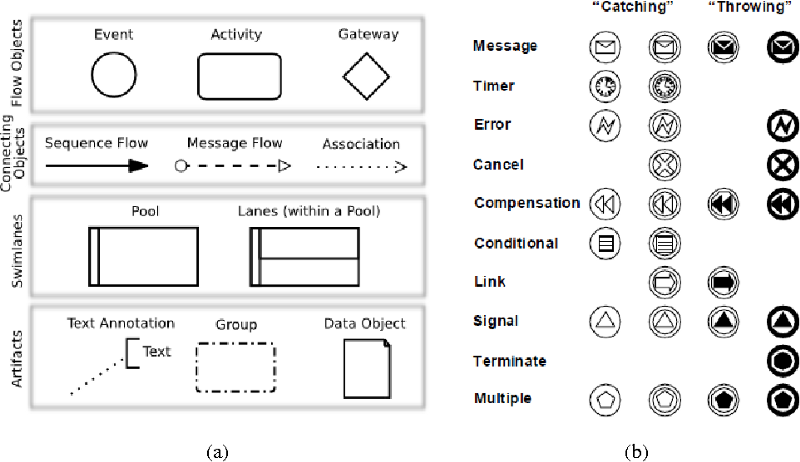
یادگیری نشانهگذاری BPMN به روشی آسانتر
آنچه منتقدان به آن اشاره نمیکنند این است که بیشتر فرآیندها نیاز ندارند که مدلساز تمام مشخصات را بداند. در واقع، بیشتر مدلها از بیش از چند عنصر رایج فرآیند استفاده نمیکنند.
در واقع، BPMN فقط از 3 عنصر اصلی تشکیل شده است:
- رویدادها
- فعالیتها
- دروازهها
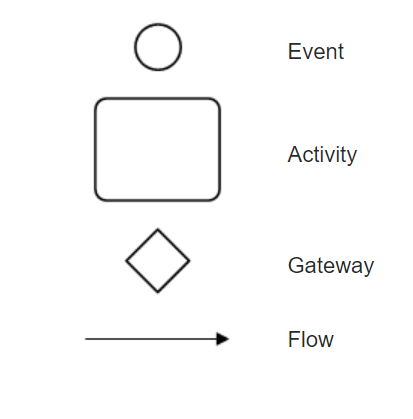
بله، درست است. فقط سه عنصر اصلی در BPMN وجود دارد! خوب، بیایید یک عنصر چهارم اضافه کنیم تا بتوانیم سه عنصر دیگر را به هم متصل کنیم – جریان توالی (خطوط سیاه با پیکانهایی که همه چیز را به هم متصل میکند).
شاید اگر بتوانید مجموعهای از عناصر اصلی BPMN که بیشتر استفاده میشوند را حفظ کنید، باید برای بیشتر مشکلات شما کافی باشد:
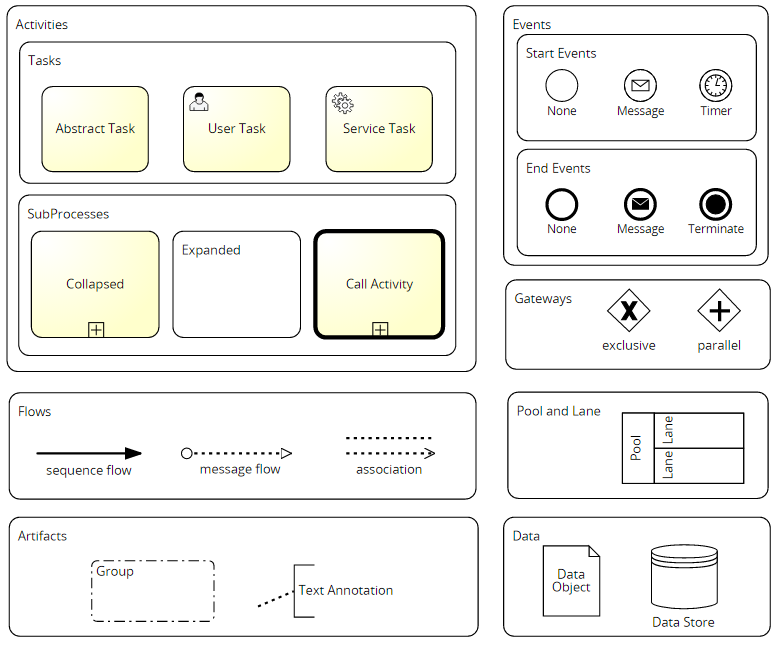
یادگیری BPMN با مثال
همانطور که برخی منتقدان میگویند، BPMN نمادها و نشانهگذاریهای زیادی دارد. حفظ همه آنها چندان آسان نیست. در ابتدا، باید از مجموعه اصلی عناصر BPMN استفاده کنیم و به تدریج با مواجهه با مشکلات بیشتر، بیشتر یاد بگیریم. بهترین راه برای درک معنی آنها، یادگیری آنها از طریق مثالها و الگوها است.
در اینجا چند مثال BPMN برای شما به عنوان نقطه شروع ارائه میدهم و برای سفر اکتشافی شما آرزوی موفقیت میکنم.
این مثال نمودار فرآیند کسبوکار، فرآیندی از یک دپارتمان کسبوکار به منابع انسانی را نشان میدهد که با گزارش یک فرصت شغلی آغاز میشود و با انتشار آگهی شغلی که شامل جریانها، وظایف، رویدادهای شروع و پایان و دروازهها است، به پایان میرسد.
مثال نمودار فرآیند کسبوکار: انتشار آگهی شغلی
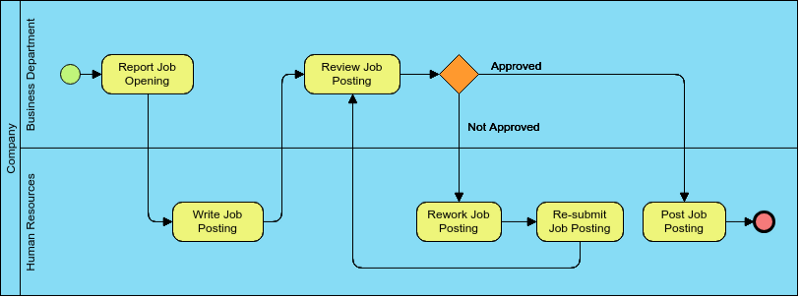
ویرایش مثال بالا به صورت آنلاین
مثال نمودار فرآیند کسبوکار: سیستم مدیریت تأمینکنندگان
این یک نمودار فرآیند BPMN برای مدیریت تأمینکنندگان است. این نمودار یک فرآیند خرید آینده برای ایجاد تأمینکنندگان جدید را نشان میدهد. این BPM چندین وظیفه، دروازهها (تصمیمات) و اتصالات را نشان میدهد.

ویرایش مثال بالا به صورت آنلاین
مثال نمودار فرآیند کسبوکار: درخواست قیمت
این یک مثال BPD است که فرآیندی برای درخواست یک نقل قول را توصیف میکند. این فعالیتها، یک رویداد برای زمانبر بودن و یک نشانگر را که در حلقههای زیر فرآیند نشان میدهد، نشان میدهد.
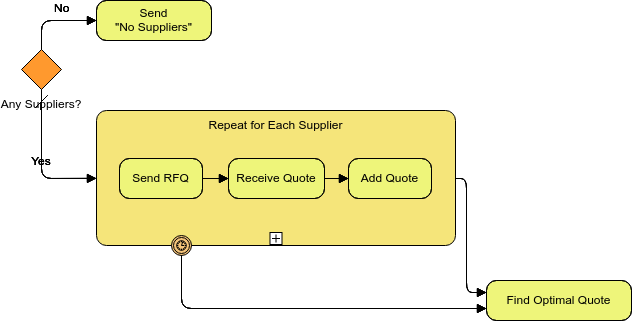

This post is also available in Deutsch, English, Español, Français, Bahasa Indonesia, 日本語, Polski, Portuguese, Ру́сский, Việt Nam, 简体中文 and 繁體中文.













